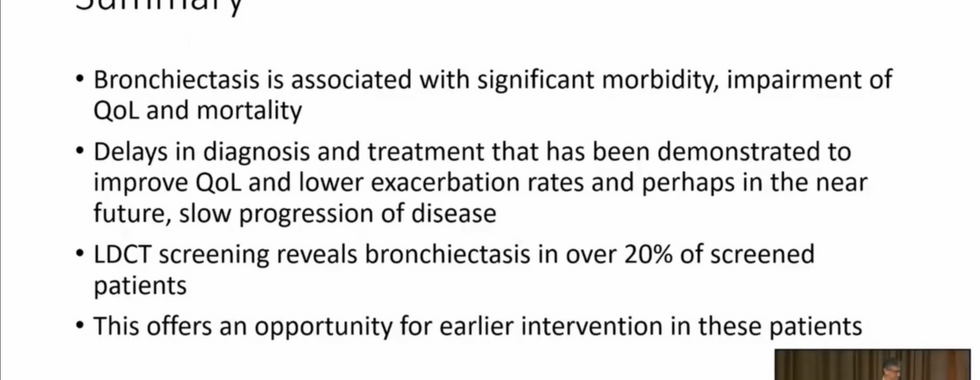Part 14 of 49 - Video Presentations of the "1st Conference on Integrating Early Detection of Heart and Lung Disease through Low-Dose CT": Day 1 Session 2: Bronchiectasis
- miguel65063
- Jan 13
- 6 min read
Thursday, September 19, 2024 | New York Academy of Medicine (NYAM)
1216 5th Ave, New York, NY 10029
Dr. Mark L. Metersky, MD emphasized the importance of early detection and treatment of bronchiectasis. He noted that delays in diagnosis are common and detrimental. Although there is no cure or FDA-approved therapies, early diagnosis can enhance the quality of life and decrease exacerbations, which increase hospitalization and mortality rates. In addition, he highlighted the utility of low-dose CT scans in early identification and stressed the need for timely evaluation and intervention. Dr. Metersky also discussed promising new therapies and the role of pulmonologists in managing the disease.
Watch Dr. Mark Metersky's Presentation Below:
See Dr. Mark Metersky's Slides Below:
-
Transcript of Dr. Mark Metersky's Presentation:
[Mark Metersky] [1.28s] Thank you, David, and for to Claudia for inviting me to this, speak of this very interesting session.
[Mark Metersky] [7.52s] I guess I'm sort of a poser.
[Mark Metersky] [9.04s] I've had a bronchiectasis program at the University of Connecticut for only 15 years, so it's only been half of my professional life's work because I've been in practice for about 30 years.
[Mark Metersky] [19.09s] I changed the title slightly, bronchiectasis averting premature death and morbidity by earlier detection.
[Mark Metersky] [28.58s] And I do have some disclosures, some consulting clinical trial support, and some data safety monitoring committees.
[Mark Metersky] [38.50s] If I only had one slide instead of 8 minutes, this is the one I'd show.
[Mark Metersky] [42.66s] This is a new patient referred to me, had never seen a pulmonologist for cough.
[Mark Metersky] [48.41s] This is the CAT scan result.
[Mark Metersky] [49.85s] Right?
[Mark Metersky] [50.41s] This this patient clearly had not been coughing for only a few weeks or a few months, maybe even not a few years.
[Mark Metersky] [57.28s] And delays in diagnosis persists.
[Mark Metersky] [59.52s] This is from Europe where they are probably also ahead of us, if not if equal to it, if not ahead of us in some ways in their in their bronchiectasis care, but, from very sophisticated, practitioners.
[Mark Metersky] [72.28s] And as you can see, in the bottom part of this slide, the years of symptoms prior to diagnosis, only 12% had symptoms for less than a year.
[Mark Metersky] [81.67s] Most of them had symptoms for 2 years or longer.
[Mark Metersky] [85.83s] So and and I'm sure we'd see similar data in the United States if we looked.
[Mark Metersky] [92.22s] The question arises though, do these delays matter?
[Mark Metersky] [96.22s] Clearly, there is no cure for bronchiectasis other than the rare patient who has focal disease that's severe that we can take it out surgically, And there are no FDA approved therapies for bronchiectasis.
[Mark Metersky] [110.06s] So it doesn't matter.
[Mark Metersky] [112.06s] I'm gonna try and convince you that it does.
[Mark Metersky] [114.30s] This is, these are data from from our site.
[Mark Metersky] [117.74s] This is still to date the longest quality of life study in bronchiectasis that I'm aware of.
[Mark Metersky] [123.25s] It wasn't in a in a high, impact journal because we only had 20 some patients, but, this is improvement in quality of life from 1 point 1 is when they were first visit, and then, you can see that they improved.
[Mark Metersky] [141.83s] These both are in above the minimally important difference on the, bronchiectasis quality of life, and it persisted.
[Mark Metersky] [150.07s] And I was once asked at a meeting, you know, what's my protocol for for for these patients?
[Mark Metersky] [156.22s] And I don't have one specific one.
[Mark Metersky] [158.06s] It's a very heterogeneous disease, I'm sure you know.
[Mark Metersky] [160.71s] And some patients, all they got was reassurance that they're not gonna die of this, that that immediately improved their quality of life.
[Mark Metersky] [166.05s] I didn't have to do anything else.
[Mark Metersky] [167.16s] But they also got airway clearance, macrolides, etcetera, depending upon their severity.
[Mark Metersky] [173.72s] And there are worsened outcomes overall in patients, with bronchiectasis, especially those with the with frequent exacerbations.
[Mark Metersky] [182.19s] So this, looks at patients, stratified based upon their exacerbation rate at baseline.
[Mark Metersky] [188.75s] You can see that the percent that was hospitalized goes up quite significantly, the more exacerbations they have, and their mortality, the red line, the the worst mortality are are patients with more frequent exacerbations.
[Mark Metersky] [203.37s] And many of these, deaths for the cardiologists who are still here, are from cardiac events.
[Mark Metersky] [209.77s] These are older patients, so they're at risk for for cardiac disease, cardiovascular disease already, and as we know, prolonged inflammation begets coronary artery disease, as does acute inflammation, and many of these tests are shortly after, exacerbations, other studies have shown.
[Mark Metersky] [233.76s] We also have other therapy.
[Mark Metersky] [235.60s] Again, trying to convince you that it matters.
[Mark Metersky] [237.52s] Chronic low dose macrolide therapy.
[Mark Metersky] [240.08s] Bottom line is it prevents exacerbations.
[Mark Metersky] [242.72s] So we use that pretty frequently, and these are 2 large RCTs that showed that.
[Mark Metersky] [247.68s] We have airway clearance that we use.
[Mark Metersky] [250.39s] There's weak evidence in favor of improved outcomes.
[Mark Metersky] [252.79s] Nonetheless, it's considered a mainstay of therapy.
[Mark Metersky] [255.32s] Inhaled antibiotics, which has been shown in meta analyses to demonstrate significant but very limited benefit.
[Mark Metersky] [265.56s] This is one of this is an investigational compound, but I'm gonna show you the the data that, suggests strongly that we're gonna have an FDA approved treatment within about a year.
[Mark Metersky] [277.25s] This is phase 3, and this is one of the companies I've consulted with, so full disclosure.
[Mark Metersky] [283.72s] So the phase 3 RCT was completed.
[Mark Metersky] [285.96s] It's a dipeptidyl peptidase inhibitor.
[Mark Metersky] [287.96s] It prevents activation of neutrophil serine proteases, which including neutrophil assays, which are released in response to chronic airway infection, and the the airway, is the is the innocent bystander, is the collateral damage.
[Mark Metersky] [309.94s] And this is the top line data from this phase 3 study, which has been presented, and you can see that there's a statistically, and I'll argue, clinically significant decrease rate of exacerbations.
[Mark Metersky] [321.40s] This was a, 2 doses that were studied, and both of them worked for exacerbations.
[Mark Metersky] [327.00s] But perhaps even more exciting is, the higher dose, so the purple line up top, shows, improved FEV 1.
[Mark Metersky] [337.96s] So the the the delta in FEV 1 in a 1 year study was significantly less.
[Mark Metersky] [344.20s] The drop in FEV 1 was significantly less in placebo, in the higher dose than in the placebo and 10 milligram dose.
[Mark Metersky] [351.32s] So for the first time, we have something that may that prevents exacerbations and may be disease modifying, which is really the holy grail, for airways disease, whether it be asthma quite frankly, COPD, or bronchiectasis.
[Mark Metersky] [368.62s] So moving back to low dose CT scan, hopefully having convinced you that it matters because that's the first argument, is doesn't make a difference.
[Mark Metersky] [377.90s] It's incredibly common.
[Mark Metersky] [380.39s] This is a a yet another study from Mount Sinai.
[Mark Metersky] [384.31s] So I was looking at l low dose CT in in smokers, 20, over 2,000 participants.
[Mark Metersky] [390.56s] Bronchiectasis was found in about 23%, 504 of them.
[Mark Metersky] [396.92s] The prevalence was high, obviously.
[Mark Metersky] [403.08s] And in addition, respiratory symptoms and acute events such as exacerbations, hospitalizations were more, were more frequent in patients detected this way who had increasing severity of bronchiectasis based upon, the bronchiectasis score, radiographic score, developed again, here at Sinai with David and Claudia.
[Mark Metersky] [426.10s] So this isn't just some CT finding that has no relevance.
[Mark Metersky] [431.62s] These patients are clinically clinically sicker.
[Mark Metersky] [435.30s] This is another study from Europe looking at 855 stable COPD patients.
[Mark Metersky] [441.57s] They found 42%.
[Mark Metersky] [444.30s] These were really patients with very severe COPD, so I think that accounts for the 40 versus 20%.
[Mark Metersky] [451.01s] I mean, I am not gonna stand here and say that 40% of COPD patients have clinically significant bronchiectasis.
[Mark Metersky] [456.62s] You know?
[Mark Metersky] [457.34s] We know that isn't the case just from practicing for years.
[Mark Metersky] [461.10s] Again, it it correlated with with severity of bronchiectasis, exacerbations, things like that, and pneumonia was more frequent.
[Mark Metersky] [469.31s] So these are, again, clinically important findings in these patients.
[Mark Metersky] [476.26s] So moving back, I think it's the same theme we've we've already heard is, yes, we've we've found this.
[Mark Metersky] [482.26s] What are we gonna do about it?
[Mark Metersky] [483.62s] And the challenge and the imperative will be to ensure that the patients in whom it's incidental finding will then receive appropriate evaluation and treatment.
[Mark Metersky] [492.31s] I think with EHRs and prompts and and things like that, it's probably not a hard lift to make sure that these patients, once they're detected, get to a pulmonologist.
[Mark Metersky] [505.97s] Radiologists can't do it on their own, but like I said, simple interventions can increase the likelihood of positive outcomes because detection doesn't mean anything unless we actually change outcomes.
[Mark Metersky] [515.25s] Thank you.
The presentations were hosted by I-ELCAP – The International Early Lung Cancer Action Program.






































Comments